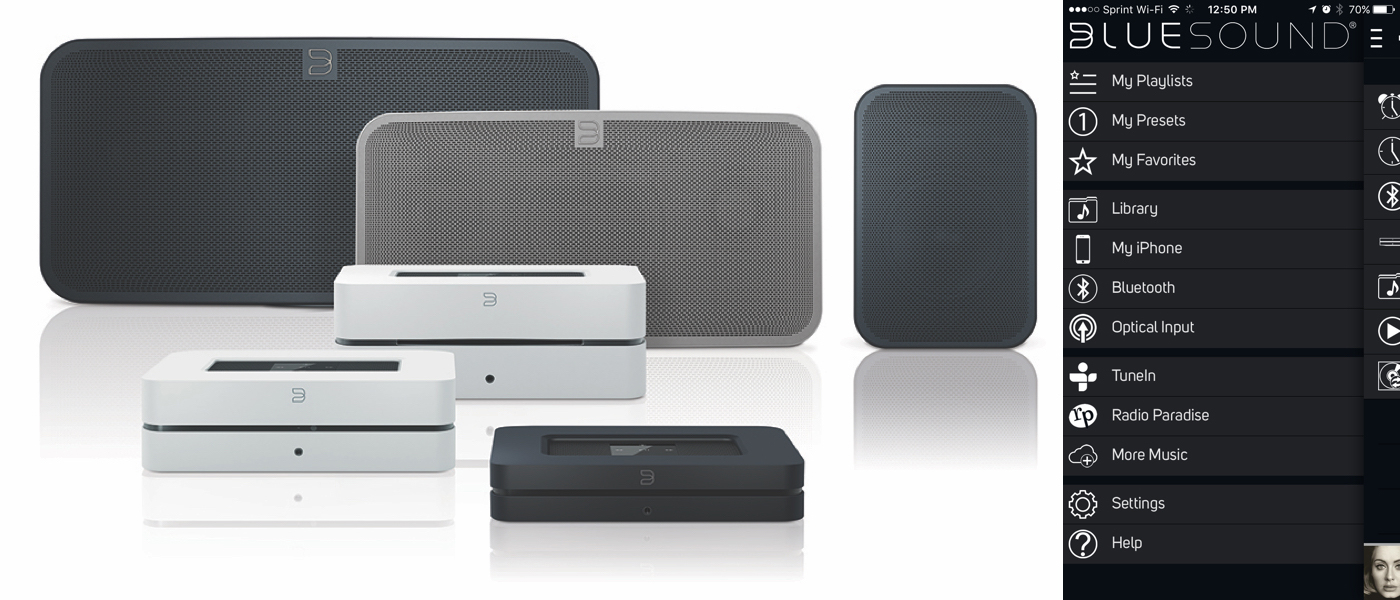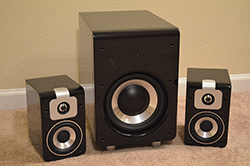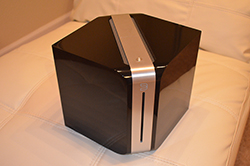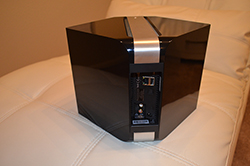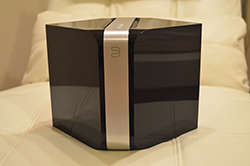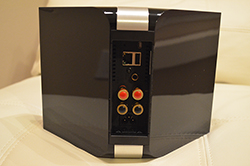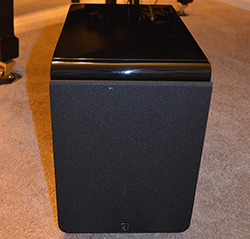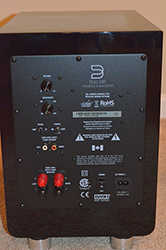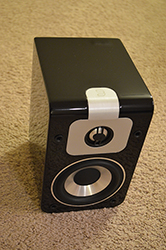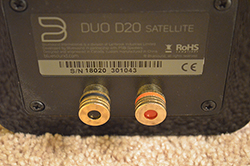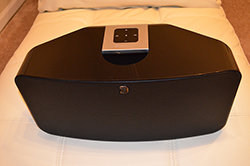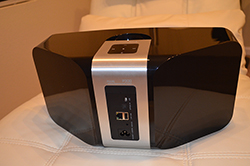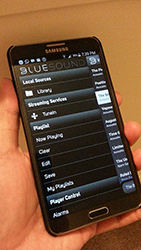As of to date, the convenience that a wireless music system offers does not often translate into high fidelity sound. But somehow, Bluesound manages to pull these seemingly contradicting features off in its current product line. The products reviewed here work well synergistically as a Wi-Fi networked music system that can provide music in various rooms of the house. Its well-balanced high-fidelity sound should satisfy even the most discerning music lovers.
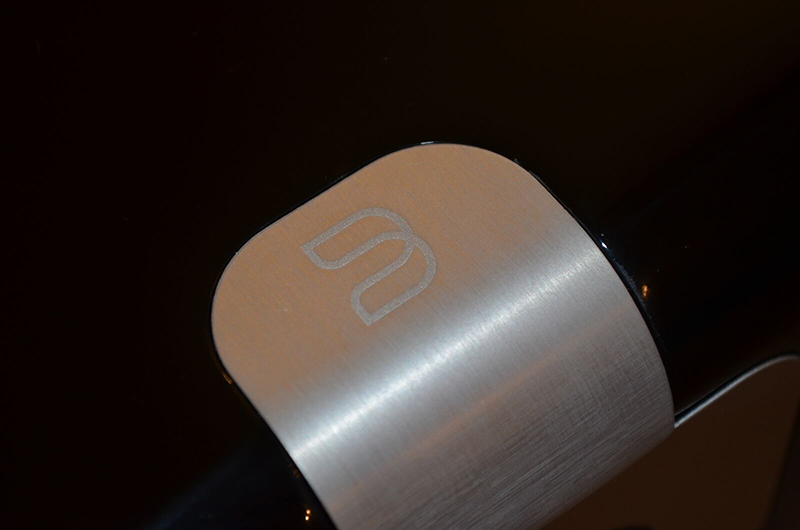
Bluesound Wireless Multi-room Music System
- Classy-looking wireless (Wi-Fi) streaming music system.
- Excellent build quality and beautiful glossy finish.
- Self-contained digital cloud music system with the Vault utilizing your own Wi-Fi network.
- Convenient system configuration, management, and operation using smartphone, tablet, or computer.
- Well-balanced smooth-sounding system.
One of the reasons why I chose to become a reviewer was the opportunity to experience new products first-hand. When a product to be reviewed is on its way to me, I feel like a little kid waiting impatiently for my toy to arrive. Just like some toys bring more excitement than the others, somehow this Bluesound system intrigued me more than most other products I had the pleasure to review.
Bluesound Vault, Powernode, Pulse
Supported File Formats:
MP3, AAC, WMA, OGG, WMA-L, FLAC, ALAC, WAV, AIFF
Native Sampling Rates:
32, 44.1, 48, 88.2, 96, 176.4, 192 kHz
Bit Depths:
16, 24
Supported Operating Systems:
Plays music from network shares on the following desktop operating systems: Microsoft Windows XP, 2000, Vista, 7, 8, Apple Macintosh
Performance:
SNR – 100dB, distortion – 0.005%
Free Internet Radio:
TuneIn Radio
Album Art:
JPG
Supported Cloud Services:
WiMP, Rdio, Slacker Radio, Qobuz, HighResAudio, JUKE, Deezer, Rhapsody, Murfie, HDTracks, Spotify, TIDAL
User Interface:
Android free app, iOS free app, top-panel mute button with integrated tri-color status LED, volume control buttons (for Powernode)
Bluesound Vault
Storage:
2TB internal hard-drive with low acoustic emissions and power consumption
CD:
Slot-loading mechanism for ripping standard audio CDs
Connectivity:
Ethernet RJ45, USB Type-B mini port for product servicing, USB Type-A port for connection to USB memory sticks and supported peripherals, analog RCA stereo jack, TOSLINK digital optical output
Power:
12VDC input (External universal AC power supply included)
Dimensions:
8.25″ H x 9.5″ W x 11.6″ D
Weight:
6.6 Pounds
Power Consumption:
17 Watts
MSRP:
$999 USD
Bluesound Powernode
Amplification:
DirectDigital Amplifier by NAD Electronics 50w x 2 (4 ohms)
Performance:
SNR – 100dB (A-weighted), distortion – 0.005% THD
Connectivity:
Ethernet RJ45, 802.11n Wi-Fi, USB type-B mini port for product servicing, USB type-A port for connection to USB memory sticks and supported peripherals, stereo loudspeaker output jacks, RCA subwoofer output jack
Power:
Universal tri-pin AC cord input (120 – 240VAC)
Dimensions:
9.8″ H x 5.8″ W x 8″ D
Weight:
2 Pounds
Power Consumption:
12 Watts
MSRP:
$699 USD
Bluesound Duo
Frequency Range (SUB):
On Axis @ 0°±3dB – 36 – 150Hz, LF Cutoff -10dB – 32Hz
Frequency Range (SATS):
On Axis @ 0°±3dB: 75 – 23,000 Hz, Off Axis @ 30°±3dB: 80 – 10 kHz, LF Cutoff -10dB: 65Hz
Amplifier Type:
Class H Discrete MOSFET
Amplifier Power (SUB):
Continuous – 110 Watts, Dynamic – 140 Watts, Dynamic Peak – 280 Watts
Inputs:
Gold-plated RCA high-level stereo receiver inputs, gold-plated RCA low-level stereo preamp inputs
User Interface:
Precision Volume Control, Crossover control with LFE setting, Phase Switch, On-Auto-Off Switch
Power:
Two-pin AC cord (110 – 240 VAC)
Power Consumption:
EnergyStar certified 0.5 Watt auto standby mode
Dimensions:
(SUB) 9.8″ H x 14.9″ W x 15.9″ D, (SATS) 5.1″ H x 8.45″ W x 7.2″ D
Weight:
(SUB) 24.5 Pounds; (SATS) 5.35 Pounds/each (2)
MSRP:
$999 USD
Bluesound Pulse
Amplification:
Bi-amplified Direct-Digital Amplifier by NAD Electronics with 80 watts total power, 0.005% THD
Performance:
Distortion – 0.005%, Acoustic Frequency Response – 45 Hz – 20 KHz
Connectivity:
Ethernet RJ45, 802.11n WiFi, USB type-B mini port for product servicing, USB type-A port for connection to USB memory sticks and supported peripherals, TOSLINK digital optical input, trigger output
Power:
Universal tri-pin AC cord input (120 – 240VAC)
Dimensions:
16.7″ H x 7.8″ W x 7.54″ D
Unit Weight:
13.5 Pounds
Power Consumption:
14 Watts
MSRP:
$699 USD
Company:
SECRETS Tags:
Bluesound, Bluesound Wireless, Multi-room Music Systems
It might be because the system promises something different than most of the music systems out there at the moment. For once, it is marketed as a whole-house wireless hi-fi music system, which is not too many out there can claim to be one. Part of my excitement was also due to my impression that this system might represent what the future of hi-fi music system would morph into. As usually the case, with high excitement comes high expectation…
In its website, Bluesound is described as a company built by an alliance of audiophiles dedicated to deliver wireless high fidelity audio to the music lovers, and more importantly to fellow audiophiles who always demand high fidelity over anything else. The keywords here are wireless and high fidelity, two features that are often thought not a good mix.
The engineers behind Bluesound are from NAD and PSB, so they are not strangers to high-fidelity sound. And the very attention to sound quality driven with the convenience of wireless technology is what Bluesound tries to instill in its products. It is not a walk in the park for sure, and let us see whether the company succeeds in its quest.
The Bluesound system was shipped in two well-packed boxes. Although packaging does not contribute to the product quality, it does reflect the company’s pride toward its creations. While it is true that these nice boxes may not linger long and perhaps may hitch a ride to a garbage truck the next day after the unpacking of the products, but still, they build the first impression about the products. Bluesound’s attention to details is quite obvious also from the accessories supplied with the products, which are packaged and labeled nicely. All these could impart pride of ownership too!
Bluesound’s current product ecosystem includes the Vault, Powernode, Node, Duo, and Pulse. For this review, Bluesound sent me all products in its current lineup except for the Node, which has a similar functionality as the Powernode. The Node can accommodate integration with the existing conventional hi-fi system, while the Powernode is more for a stand-alone application.
Design, Features, and Set up of the Bluesound Wireless Multi-room Music System
The Vault serves as the digital cloud music server for the whole Bluesound system. It has the functionality to rip your CD collection through its CD drive and store the results in its internal hard drive. You can choose to rip your music collection in uncompressed WAV format, high-quality lossless FLAC (Free Lossless Audio Codec) format, or the space-saving MP3 format.
For the MP3 format, you can choose the bitrate for the ripping (labeled as moderate, good, and best). The version of the Vault for review is equipped with a 2 TB hard drive, which is plenty of space to accommodate most personal music collections. The Vault can also serve as the low-level signal source for your existing hi-fi system.
The Powernode, as the name implies, has a stereo amplifier in it (50 W x 2 into 4 ohm) to power a pair of passive speakers. The amplifier is of the DirectDigital type, which was developed by NAD Electronics. With a stand-alone Powernode and a pair of speakers, you can play music by streaming online radio (through TuneIn) or other cloud services, or play the music files from a USB flash drive.
If that is not enough, you will need to link the Powernode with the Vault through the Wi-Fi network to play the music collection stored in the Vault. The Powernode is missing a feature that I would love to have: input-output connectors for the integration with the conventional hi-fi system. But fret not; if integration with your existing conventional system is what you are after, the Node is the Bluesound answer for it.
The Duo has the appearance of a typical sub-sat system, and it can be used as one too. The subwoofer of the Duo has an 8-inch driver powered by its own Class H Discrete Mosfet amplifier capable of producing 280 W of dynamic peak. The satellite speakers are two way containing 4-inch woofer and 1-inch dome tweeter.
Both the Duo subwoofer and satellites come with removable fabric grills. What differentiates the Duo with other sub-sat system is the specific equalization in it for pairing with the DirectDigital amplifier of the Powernode. So, the Powernode is really the soul mate of the Duo, and pairing them will optimize the sound produced by the Duo.
At a glance, the Pulse looks like a Bluetooth speaker on steroids. But function-wise, it is very different than regular Bluetooth speakers. Just like the Powernode, the Pulse can stream internet radio or other music cloud services, play music on connected USB flash drive, or play the music collection from the Vault.
The Pulse packs an 80 W total DirectDigital amplification, which is used to drive its own internal stereo speakers. Of the Bluesound ecosystem, the Pulse is the truly independent component, which does not require the support of the other components from the ecosystem to generate the music.
Overall, this Bluesound bunch has a classy and modern-looking design. It exhibits artistic appearance that I would proudly display in my house. It is the type of design that could easily blend in with most room decor. The Bluesound build quality seems excellent and the glossy finish interwoven with brushed aluminum panels is beautiful. My review sample comes in glossy black, as you can see from the photos, but glossy white finish is also available.
For the review, I set up the Bluesound system following the instruction manuals. These manuals, which are written with only very few words and utilizes mostly pictorial diagrams, were easy to follow, but being rather technically inclined, I felt that they were too simplistic. It was enough to allow you to make proper interconnection of the Bluesound components, but it did not describe the technical features of each product adequately. With these manuals, you won’t know what’s under the hood.
The Vault requires wired internet connection; hence I placed it near my router in my multi-purpose room. The Duo connected to the Powernode was placed in the living room. While the Pulse was used in one of the bedrooms upstairs. The Powernode and the Pulse were connected through my household Wi-Fi network, which has a 15 MB/s download and 2 MB/s upload speeds.
Before use, each of the wireless Bluesound components needs to be registered to the Wi-Fi network they will be operating in. I did that by following the steps given in the manual. The process is quite simple and went on smoothly. I also downloaded the app to manage the Bluesound system to my home Windows PC and to my Android phone: Samsung Galaxy Note 3.
Installation of the app was a snap and no glitches were experienced. If you are an Apple user, the Apple iOS version of the app is also available. The Bluesound system does not come with a remote control, so control of your Bluesound component remotely is done through your Android or Apple smartphones connected to the same Wi-Fi network.
The Bluesound app will automatically recognized the Bluesound components within the same Wi-Fi network. From the app, you can control the operation of the Bluesound components, such as configuring a Bluesound component, adding or removing components to be made active, editing the playlist, choosing the music source, changing the volume, etc.
The app is intuitive to use and although its graphical user interface can be made better, I did not experience any serious glitches with the app during the review. What I experienced was only a Bluesound component disappearing from the app, but I could easily remedied this by just resetting the missing component.
If you have another music collection in your smartphone, however, you will not be able to play it through the Bluesound system, until you have added this collection to the Bluesound library in the Vault. This might seem to limit Bluesound functionality, but I do not consider it as a big limitation. After all, Bluesound is never advertised as a portable system, so playing music from your portable device like your smartphone is not really what it is intended for.
My rather long description above might give the impression to the readers that setting up this Bluesound system is a complicated affair. But in reality, it is not! Its wireless feature made the physical setup of the system is a breeze. I could place the Powernode with the Duo or the Pulse pretty much in any location I want within the coverage of my Wi-Fi network, as long as the power source is available.
Sure, I had to deal with the software setup as well, but it was not difficult and relatively quick to do. And once it was all set and done, all I had to do was just to reap my rewards: enjoying the sound of beautiful music in my designated desired locations.
Listening Impressions
I expressed my excitement in waiting for the Bluesound system to arrive. Thus, it was understandable that as soon as the system had been set up and configured, all I wanted to do was to give the system a spin. Before I started my serious listening sessions, I first ripped a few of my favorite CDs into the Vault, some in compressed (MP3) and some in uncompressed (FLAC) formats. I copied also some of my MP3 music from my CD backup collection in my PC hard disk.
Ripping a CD using the Vault might take more than 30 minutes to complete, which was rather slow by the current standards. The CD being ripped might be ejected in about 10 minutes into the ripping process, but that does not mean that it has been completely ripped. The Vault copies the CD contents in WAV format first, and then continues on the ripping process to the format selected.
According to the information that I gathered, the slow ripping is due to the true bit ripping feature, which is based on data accuracy and not on a quick pass. Once the CD has been ripped, the Vault is able to collect the CD information from the internet CD database, including the album cover pictures if they are available.
With the excitement that I had with the Bluesound system comes also curiosity and expectation. The nice packaging, the excellent build quality, and the beautiful finish mean nothing if they are not accompanied by the strong musical performance. Does this Bluesound system meet my expectation for performance? The short answer is yes, and then some.
Let’s start with sound quality of the Powernode and Duo combination. First of all, this combo sounded good right on the first use. Nevertheless, I did break-in the speakers by playing various types of music through them for a few hours. Except for a bit smoother sound, I did not notice too much different in the sound characteristics before and after the break-in. The Duo sub-sat system overall produced nice balanced sound.
There was no noticeable excessiveness in particular frequency range that might affect the musicality of the system. I followed the suggestion from the Duo manual to start the subwoofer-level dial-setting at 12 o’clock position and then made the necessary adjustment from there. In my living room, actually the 12 o’clock subwoofer setting was about right, and my final setting was only a hair different than the initial one.
Throughout my evaluation, the Powernode/Duo combo never failed to impress me. First of all, the Duo could really sing, and sing beautifully I might add. They sound bigger than their size indicates. The bass foundation that the Duo subwoofer produced was sufficient to produce believable full-range sound reproduction. The bass produced by this little subwoofer was quite tuneful with tight transient and nice articulation.
The Duo satellites were more than capable in doing their part of the job, producing every upper-end of details in the music without ever becoming too sharp or artificial. The Duo sub-sat system was able to convey vocal with full characteristics and the right-level of sibilance. This relatively small system simply begged to be treated with respect as their bigger competitors. And respect was what I gave to it. I even tested the Duo for its imaging and soundstaging capability.
I am glad to report, that it did not disappoint in this department. With proper placement and a slight toe-in on the Duo satellites, the speakers could produce a focused image with a good-size neutral soundstage. On a small jazz ensemble music for example, the Duo was able to paint intimate musical stage that was very engaging.
As you can tell by now, I was quite impressed by the performance of the Powernode/Duo combination. Can the same be said about the Pulse? You bet it can. For a stand-alone wireless speaker system, the Pulse can definitely compete with the best out there. Again, just like the Powernode/Duo combo, the Pulse produced well-balanced sound that was not tiring for a long-time listening session. Overall it was truly a well-rounded speaker that could fill up the room with full, detailed sound with smooth treble, natural sounding mid-range and powerful bass for a speaker of its size.
The sound of the Pulse might not have the airiness and clarity of the Powernode/Duo combo, but it was still very good. And the Pulse was also a joy to listen from close distance too, so it should be very suitable for use in small room. This could be an ideal speaker for students living in a dorm room not wanting to be bothered by troublesome wired setup.
As with any music system, the quality of the sound produced is only as good as the source supplying the music. I am glad to report that the difference of the music ripped using the Vault’s lossless or lossy compression software (using the best setting for the MP3 format) is not easily differentiable, at least to my ears. And the difference would probably no longer noticeable if you do not do direct A-B comparison. So in my humble opinion, unless you are the type of person who has very sensitive ears to such small differences, the ripping format you select does not really matter.
The TuneIn internet radio, freely included with the Bluesound system, can fill your radio need nicely. You can choose the radio station offering the type of music you would like to listen. If you prefer, you can also listen to the subscribed online service like Spotify, Wimp, etc. through Bluesound. During the review, I mostly listened to some contemporary jazz radio stations through TuneIn. The fidelity of the internet radio sound of course depends on the quality of the signals it streams. But the good ones really shone through this Bluesound system.
To say that I really like the Bluesound wireless music system is an understatement. To be more precise, I love it! What’s not to love for a music system that combines the convenience of music streaming through Wi-Fi and the fidelity of a serious audiophile system? The wireless feature together with their small size and décor-friendly appearance should make this system very spouse-friendly.
While this Bluesound system does not belong to the budget-system category, the above features complimented with its excellent build quality and handsome appearance should justify its price tag. If this Bluesound system represents the direction of the evolution of the future wireless music system, I can wholeheartedly embrace the journey.


